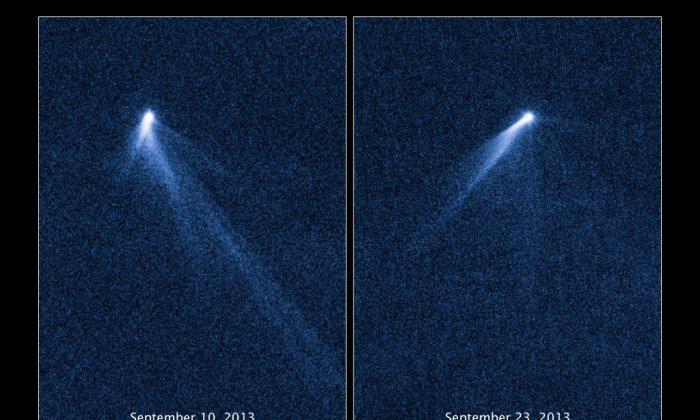New NASA images reveal an asteroid with six comet-like tails radiating out like spokes on a wheel—something they’ve never seen before.
Astronomers are puzzled by what they’re seeing through the Hubble Space Telescope since normally asteroids look more like a tiny point of light not a sprinkler.
“We were literally dumbfounded when we saw it,” said lead investigator David Jewitt of the University of California at Los Angeles in a press statement. “Even more amazing, its tail structures change dramatically in just 13 days as it belches out dust. That also caught us by surprise. It’s hard to believe we’re looking at an asteroid.”
While they can’t say for sure what’s causing what the phenomenon, they suspect the asteroid started rotating faster and faster until finally, the spin was so fast that the rock’s gravity couldn’t keep it together and its surface starting flying off.
The multiple tails were first seen on Sept. 10, then by Sept. 23 the asteroid’s appearance had totally changed.
“We were completely knocked out,” Jewitt said.
The asteroid belt P/2013 P5 that the spinning asteroid is part of has been ejecting dust over the last five months. Because of this, the researchers don’t believe what they’re seeing was caused by a collision. A collision would have caused one big blast of dust rather than this slow one. The asteroid itself a fragment of a larger one exploded in a collision probably 200 million years ago, according to Jewitt.
Despite losing dust for five months, only a fraction of the asteroid, which has a nucleus 1,400 feet wide, has been lost.
If Jewitt’s hypothesis is correct, this might actually be a common way that asteroids deteriorate. It’s simply that it hadn’t been observed before.
“In astronomy, where you find one, you eventually find a whole bunch more,” Jewitt said. “This is just an amazing object to us, and almost certainly the first of many more to come.”
The research paper on the unusual occurrence appears online in the Nov. 7 issue of the Astrophysical Journal Letters.






Friends Read Free